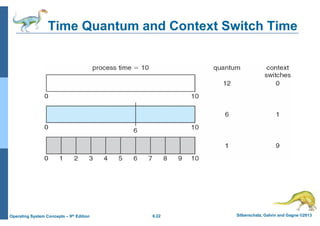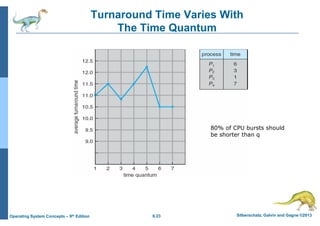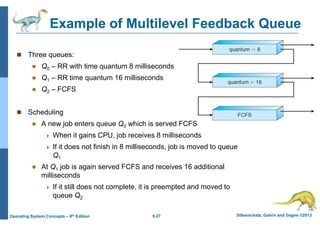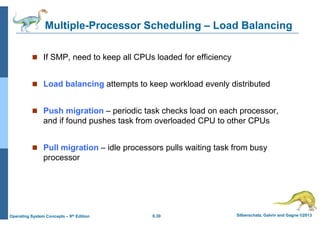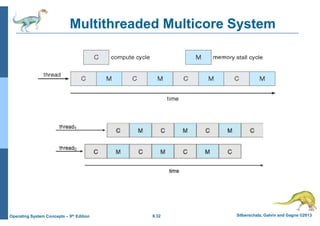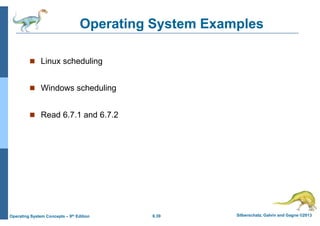cloud computing chapter one in computer science
- 1. Silberschatz, Galvin and Gagne ©2013 Operating System Concepts – 9th Edition Chapter 5: Process Scheduling
- 2. 6.2 Silberschatz, Galvin and Gagne ©2013 Operating System Concepts – 9th Edition Chapter 5: Process Scheduling Basic Concepts Scheduling Criteria Scheduling Algorithms Thread Scheduling Multiple-Processor Scheduling Real-Time CPU Scheduling Operating Systems Examples Algorithm Evaluation
- 3. 6.3 Silberschatz, Galvin and Gagne ©2013 Operating System Concepts – 9th Edition Objectives To introduce CPU scheduling, which is the basis for multiprogrammed operating systems To describe various CPU-scheduling algorithms To discuss evaluation criteria for selecting a CPU-scheduling algorithm for a particular system To examine the scheduling algorithms of several operating systems
- 4. 6.4 Silberschatz, Galvin and Gagne ©2013 Operating System Concepts – 9th Edition Basic Concepts Maximum CPU utilization obtained with multiprogramming CPU–I/O Burst Cycle – Process execution consists of a cycle of CPU execution and I/O wait CPU burst followed by I/O burst CPU burst distribution is of main concern
- 5. 6.5 Silberschatz, Galvin and Gagne ©2013 Operating System Concepts – 9th Edition Histogram of CPU-burst Times Typically large number of short CPU bursts and a small number of long CPU bursts An I/O-bound program typically has many short CPU bursts. A CPU-bound program might have a few long CPU bursts.
- 6. 6.6 Silberschatz, Galvin and Gagne ©2013 Operating System Concepts – 9th Edition CPU Scheduler Short-term scheduler selects from among the processes in ready queue, and allocates the CPU to one of them Queue may be ordered in various ways CPU scheduling decisions may take place when a process: 1. Switches from running to waiting state 2. Switches from running to ready state 3. Switches from waiting to ready 4. Terminates Scheduling under 1 and 4 is nonpreemptive All other scheduling is preemptive Consider access to shared data Consider preemption while in kernel mode Consider interrupts occurring during crucial OS activities
- 7. 6.7 Silberschatz, Galvin and Gagne ©2013 Operating System Concepts – 9th Edition Dispatcher Dispatcher module gives control of the CPU to the process selected by the short-term scheduler; this involves: switching context switching to user mode jumping to the proper location in the user program to restart that program Dispatch latency – time it takes for the dispatcher to stop one process and start another running
- 8. 6.8 Silberschatz, Galvin and Gagne ©2013 Operating System Concepts – 9th Edition Scheduling Criteria CPU utilization – keep the CPU as busy as possible Throughput – # of processes that complete their execution per time unit Turnaround time – amount of time to execute a particular process Waiting time – amount of time a process has been waiting in the ready queue Response time – amount of time it takes from when a request was submitted until the first response is produced, not output (for time-sharing environment)
- 9. 6.9 Silberschatz, Galvin and Gagne ©2013 Operating System Concepts – 9th Edition Scheduling Algorithm Optimization Criteria Max CPU utilization Max throughput Min turnaround time Min waiting time Min response time
- 10. 6.10 Silberschatz, Galvin and Gagne ©2013 Operating System Concepts – 9th Edition First-Come, First-Served (FCFS) Scheduling Process Burst Time P1 24 P2 3 P3 3 Suppose that the processes arrive in the order: P1 , P2 , P3 The Gantt Chart for the schedule is: Waiting time for P1 = 0; P2 = 24; P3 = 27 Average waiting time: (0 + 24 + 27)/3 = 17 P1 P2 P3 24 27 30 0
- 11. 6.11 Silberschatz, Galvin and Gagne ©2013 Operating System Concepts – 9th Edition FCFS Scheduling (Cont.) Suppose that the processes arrive in the order: P2 , P3 , P1 The Gantt chart for the schedule is: Waiting time for P1 = 6; P2 = 0; P3 = 3 Average waiting time: (6 + 0 + 3)/3 = 3 Much better than previous case Convoy effect - short process behind long process Consider one CPU-bound and many I/O-bound processes P1 P3 P2 6 3 30 0
- 12. 6.12 Silberschatz, Galvin and Gagne ©2013 Operating System Concepts – 9th Edition Shortest-Job-First (SJF) Scheduling Associate with each process the length of its next CPU burst Use these lengths to schedule the process with the shortest time SJF is optimal – gives minimum average waiting time for a given set of processes The difficulty is knowing the length of the next CPU request Could ask the user
- 13. 6.13 Silberschatz, Galvin and Gagne ©2013 Operating System Concepts – 9th Edition Example of SJF ProcessArr l Time Burst Time P1 0.0 6 P2 2.0 8 P3 4.0 7 P4 5.0 3 SJF scheduling chart Average waiting time = (3 + 16 + 9 + 0) / 4 = 7 P4 P3 P1 3 16 0 9 P2 24
- 14. 6.14 Silberschatz, Galvin and Gagne ©2013 Operating System Concepts – 9th Edition Determining Length of Next CPU Burst Can only estimate the length – should be similar to the previous one Then pick process with shortest predicted next CPU burst Can be done by using the length of previous CPU bursts, using exponential averaging Commonly, α set to ½ Preemptive version called shortest-remaining-time-first : Define 4. 1 0 , 3. burst CPU next the for value predicted 2. burst CPU of length actual 1. ≤ ≤ = = + α α τ 1 n th n n t ( ) . 1 1 n n n t τ α α τ − + = =
- 15. 6.15 Silberschatz, Galvin and Gagne ©2013 Operating System Concepts – 9th Edition Prediction of the Length of the Next CPU Burst
- 16. 6.16 Silberschatz, Galvin and Gagne ©2013 Operating System Concepts – 9th Edition Examples of Exponential Averaging α =0 τn+1 = τn Recent history does not count α =1 τn+1 = α tn Only the actual last CPU burst counts If we expand the formula, we get: τn+1 = α tn+(1 - α)α tn -1 + … +(1 - α )j α tn -j + … +(1 - α )n +1 τ0 Since both α and (1 - α) are less than or equal to 1, each successive term has less weight than its predecessor
- 17. 6.17 Silberschatz, Galvin and Gagne ©2013 Operating System Concepts – 9th Edition Example of Shortest-remaining-time-first Now we add the concepts of varying arrival times and preemption to the analysis ProcessA arri Arrival TimeT Burst Time P1 0 8 P2 1 4 P3 2 9 P4 3 5 Preemptive SJF Gantt Chart Average waiting time = [(10-1)+(1-1)+(17-2)+5-3)]/4 = 26/4 = 6.5 msec P1 P1 P2 1 17 0 10 P3 26 5 P4
- 18. 6.18 Silberschatz, Galvin and Gagne ©2013 Operating System Concepts – 9th Edition Priority Scheduling A priority number (integer) is associated with each process The CPU is allocated to the process with the highest priority (smallest integer ≡ highest priority) Preemptive Nonpreemptive SJF is priority scheduling where priority is the inverse of predicted next CPU burst time Problem ≡ Starvation – low priority processes may never execute Solution ≡ Aging – as time progresses increase the priority of the process
- 19. 6.19 Silberschatz, Galvin and Gagne ©2013 Operating System Concepts – 9th Edition Example of Priority Scheduling ProcessA arri Burst TimeT Priority P1 10 3 P2 1 1 P3 2 4 P4 1 5 P5 5 2 Priority scheduling Gantt Chart Average waiting time = 8.2 msec P2 P3 P5 1 18 0 16 P4 19 6 P1
- 20. 6.20 Silberschatz, Galvin and Gagne ©2013 Operating System Concepts – 9th Edition Round Robin (RR) Each process gets a small unit of CPU time (time quantum q), usually 10-100 milliseconds. After this time has elapsed, the process is preempted and added to the end of the ready queue. If there are n processes in the ready queue and the time quantum is q, then each process gets 1/n of the CPU time in chunks of at most q time units at once. No process waits more than (n-1)q time units. Timer interrupts every quantum to schedule next process Performance q large ⇒ FIFO q small ⇒ q must be large with respect to context switch, otherwise overhead is too high
- 21. 6.21 Silberschatz, Galvin and Gagne ©2013 Operating System Concepts – 9th Edition Example of RR with Time Quantum = 4 Process Burst Time P1 24 P2 3 P3 3 The Gantt chart is: Typically, higher average turnaround than SJF, but better response q should be large compared to context switch time q usually 10ms to 100ms, context switch 10 usec P1 P2 P3 P1 P1 P1 P1 P1 0 4 7 10 14 18 22 26 30
- 22. 6.22 Silberschatz, Galvin and Gagne ©2013 Operating System Concepts – 9th Edition Time Quantum and Context Switch Time
- 23. 6.23 Silberschatz, Galvin and Gagne ©2013 Operating System Concepts – 9th Edition Turnaround Time Varies With The Time Quantum 80% of CPU bursts should be shorter than q
- 24. 6.24 Silberschatz, Galvin and Gagne ©2013 Operating System Concepts – 9th Edition Multilevel Queue Ready queue is partitioned into separate queues, eg: foreground (interactive) background (batch) Process permanently in a given queue Each queue has its own scheduling algorithm: foreground – RR background – FCFS Scheduling must be done between the queues: Fixed priority scheduling; (i.e., serve all from foreground then from background). Possibility of starvation. Time slice – each queue gets a certain amount of CPU time which it can schedule amongst its processes; i.e., 80% to foreground in RR, 20% to background in FCFS
- 25. 6.25 Silberschatz, Galvin and Gagne ©2013 Operating System Concepts – 9th Edition Multilevel Queue Scheduling
- 26. 6.26 Silberschatz, Galvin and Gagne ©2013 Operating System Concepts – 9th Edition Multilevel Feedback Queue A process can move between the various queues; aging can be implemented this way Multilevel-feedback-queue scheduler defined by the following parameters: number of queues scheduling algorithms for each queue method used to determine when to upgrade a process method used to determine when to demote a process method used to determine which queue a process will enter when that process needs service
- 27. 6.27 Silberschatz, Galvin and Gagne ©2013 Operating System Concepts – 9th Edition Example of Multilevel Feedback Queue Three queues: Q0 – RR with time quantum 8 milliseconds Q1 – RR time quantum 16 milliseconds Q2 – FCFS Scheduling A new job enters queue Q0 which is served FCFS When it gains CPU, job receives 8 milliseconds If it does not finish in 8 milliseconds, job is moved to queue Q1 At Q1 job is again served FCFS and receives 16 additional milliseconds If it still does not complete, it is preempted and moved to queue Q2
- 28. 6.28 Silberschatz, Galvin and Gagne ©2013 Operating System Concepts – 9th Edition Multiple-Processor Scheduling CPU scheduling more complex when multiple CPUs are available Homogeneous processors within a multiprocessor Asymmetric multiprocessing – only one processor accesses the system data structures, alleviating the need for data sharing Symmetric multiprocessing (SMP) – each processor is self-scheduling, all processes in common ready queue, or each has its own private queue of ready processes Currently, most common Processor affinity – process has affinity for processor on which it is currently running soft affinity hard affinity Variations including processor sets
- 29. 6.29 Silberschatz, Galvin and Gagne ©2013 Operating System Concepts – 9th Edition NUMA and CPU Scheduling Note that memory-placement algorithms can also consider affinity
- 30. 6.30 Silberschatz, Galvin and Gagne ©2013 Operating System Concepts – 9th Edition Multiple-Processor Scheduling – Load Balancing If SMP, need to keep all CPUs loaded for efficiency Load balancing attempts to keep workload evenly distributed Push migration – periodic task checks load on each processor, and if found pushes task from overloaded CPU to other CPUs Pull migration – idle processors pulls waiting task from busy processor
- 31. 6.31 Silberschatz, Galvin and Gagne ©2013 Operating System Concepts – 9th Edition Multicore Processors Recent trend to place multiple processor cores on same physical chip Faster and consumes less power Multiple threads per core also growing Takes advantage of memory stall to make progress on another thread while memory retrieve happens
- 32. 6.32 Silberschatz, Galvin and Gagne ©2013 Operating System Concepts – 9th Edition Multithreaded Multicore System
- 33. 6.33 Silberschatz, Galvin and Gagne ©2013 Operating System Concepts – 9th Edition Real-Time CPU Scheduling Can present obvious challenges Soft real-time systems – no guarantee as to when critical real-time process will be scheduled Hard real-time systems – task must be serviced by its deadline Two types of latencies affect performance 1. Interrupt latency – time from arrival of interrupt to start of routine that services interrupt 2. Dispatch latency – time for schedule to take current process off CPU and switch to another
- 34. 6.34 Silberschatz, Galvin and Gagne ©2013 Operating System Concepts – 9th Edition Real-Time CPU Scheduling (Cont.) Conflict phase of dispatch latency: 1. Preemption of any process running in kernel mode 2. Release by low-priority process of resources needed by high-priority processes
- 35. 6.35 Silberschatz, Galvin and Gagne ©2013 Operating System Concepts – 9th Edition Priority-based Scheduling For real-time scheduling, scheduler must support preemptive, priority-based scheduling But only guarantees soft real-time For hard real-time must also provide ability to meet deadlines Processes have new characteristics: periodic ones require CPU at constant intervals Has processing time t, deadline d, period p 0 ≤ t ≤ d ≤ p Rate of periodic task is 1/p
- 36. 6.36 Silberschatz, Galvin and Gagne ©2013 Operating System Concepts – 9th Edition Rate Monotonic Scheduling A priority is assigned based on the inverse of its period Shorter periods = higher priority; Longer periods = lower priority P1 is assigned a higher priority than P2.
- 37. 6.37 Silberschatz, Galvin and Gagne ©2013 Operating System Concepts – 9th Edition Missed Deadlines with Rate Monotonic Scheduling
- 38. 6.38 Silberschatz, Galvin and Gagne ©2013 Operating System Concepts – 9th Edition Earliest Deadline First Scheduling (EDF) Priorities are assigned according to deadlines: the earlier the deadline, the higher the priority; the later the deadline, the lower the priority
- 39. 6.39 Silberschatz, Galvin and Gagne ©2013 Operating System Concepts – 9th Edition Operating System Examples Linux scheduling Windows scheduling Read 6.7.1 and 6.7.2
- 40. 6.40 Silberschatz, Galvin and Gagne ©2013 Operating System Concepts – 9th Edition Linux Scheduling Through Version 2.5 Prior to kernel version 2.5, ran variation of standard UNIX scheduling algorithm Version 2.5 moved to constant order O(1) scheduling time Preemptive, priority based Two priority ranges: time-sharing and real-time Real-time range from 0 to 99 and nice value from 100 to 140 Map into global priority with numerically lower values indicating higher priority Higher priority gets larger q Task run-able as long as time left in time slice (active) If no time left (expired), not run-able until all other tasks use their slices All run-able tasks tracked in per-CPU runqueue data structure Two priority arrays (active, expired) Tasks indexed by priority When no more active, arrays are exchanged Worked well, but poor response times for interactive processes
- 41. 6.41 Silberschatz, Galvin and Gagne ©2013 Operating System Concepts – 9th Edition Linux Scheduling (Cont.) Real-time scheduling according to POSIX.1b Real-time tasks have static priorities Real-time plus normal map into global priority scheme Nice value of -20 maps to global priority 100 Nice value of +19 maps to priority 139
- 42. 6.42 Silberschatz, Galvin and Gagne ©2013 Operating System Concepts – 9th Edition Linux Scheduling in Version 2.6.23 + Completely Fair Scheduler (CFS) Scheduling classes Each has specific priority Scheduler picks highest priority task in highest scheduling class Rather than quantum based on fixed time allotments, based on proportion of CPU time 2 scheduling classes included, others can be added 1. default 2. real-time Quantum calculated based on nice value from -20 to +19 Lower value is higher priority Calculates target latency – interval of time during which task should run at least once Target latency can increase if say number of active tasks increases CFS scheduler maintains per task virtual run time in variable vruntime Associated with decay factor based on priority of task – lower priority is higher decay rate Normal default priority yields virtual run time = actual run time To decide next task to run, scheduler picks task with lowest virtual run time
- 43. 6.43 Silberschatz, Galvin and Gagne ©2013 Operating System Concepts – 9th Edition CFS Performance
- 44. 6.44 Silberschatz, Galvin and Gagne ©2013 Operating System Concepts – 9th Edition Windows Scheduling Windows uses priority-based preemptive scheduling Highest-priority thread runs next Dispatcher is scheduler Thread runs until (1) blocks, (2) uses time slice, (3) preempted by higher-priority thread Real-time threads can preempt non-real-time 32-level priority scheme Variable class is 1-15, real-time class is 16-31 Priority 0 is memory-management thread Queue for each priority If no run-able thread, runs idle thread
- 45. 6.45 Silberschatz, Galvin and Gagne ©2013 Operating System Concepts – 9th Edition Windows Priority Classes Win32 API identifies several priority classes to which a process can belong REALTIME_PRIORITY_CLASS, HIGH_PRIORITY_CLASS, ABOVE_NORMAL_PRIORITY_CLASS,NORMAL_PRIORITY_CLASS, BELOW_NORMAL_PRIORITY_CLASS, IDLE_PRIORITY_CLASS All are variable except REALTIME A thread within a given priority class has a relative priority TIME_CRITICAL, HIGHEST, ABOVE_NORMAL, NORMAL, BELOW_NORMAL, LOWEST, IDLE Priority class and relative priority combine to give numeric priority Base priority is NORMAL within the class If quantum expires, priority lowered, but never below base If wait occurs, priority boosted depending on what was waited for Foreground window given 3x priority boost Windows 7 added user-mode scheduling (UMS) Applications create and manage threads independent of kernel For large number of threads, much more efficient UMS schedulers come from programming language libraries like C++ Concurrent Runtime (ConcRT) framework
- 46. 6.46 Silberschatz, Galvin and Gagne ©2013 Operating System Concepts – 9th Edition Windows Priorities

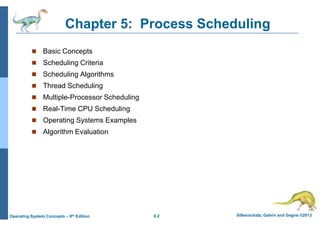

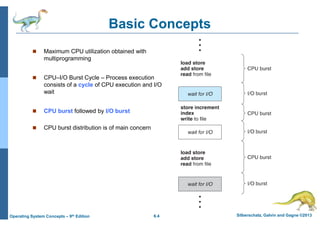

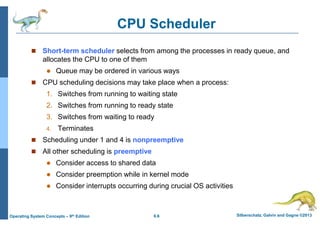

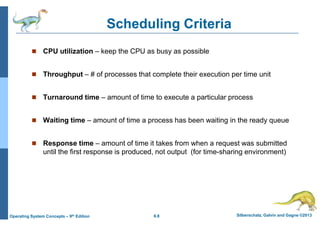
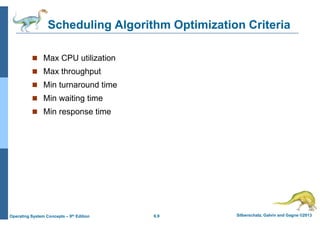


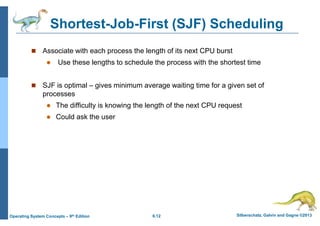
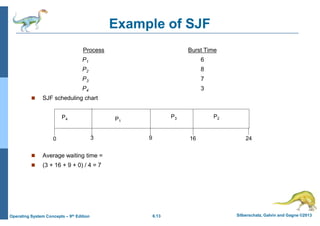
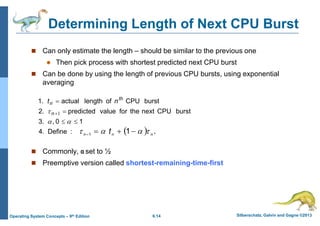
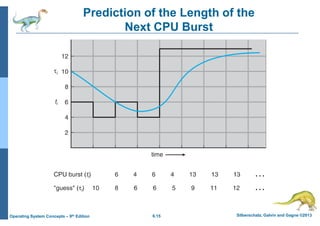
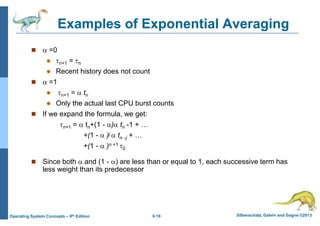
![6.17 Silberschatz, Galvin and Gagne ©2013
Operating System Concepts – 9th Edition
Example of Shortest-remaining-time-first
Now we add the concepts of varying arrival times and preemption to the analysis
ProcessA arri Arrival TimeT Burst Time
P1 0 8
P2 1 4
P3 2 9
P4 3 5
Preemptive SJF Gantt Chart
Average waiting time = [(10-1)+(1-1)+(17-2)+5-3)]/4 = 26/4 = 6.5 msec
P1
P1
P2
1 17
0 10
P3
26
5
P4](https://image.slidesharecdn.com/ch05-240421233454-0dc97f2a/85/cloud-computing-chapter-one-in-computer-science-17-320.jpg)




